
Here you can study for the exam. Look up keywords and learn definitions about all kind of subjects.
More subjects
The Honda S2000 is an open top sports car that was manufactured by Japanese automobile manufacturer Honda, from 1999 until 2009. First shown as a concept car called the SSM at the Tokyo Motor Show in 1995, the production version was launched on April 15, 1999, to celebrate the company's 50th anniversary. The S2000 is named for its engine displacement of two litres, carrying on in the tradition of the S500, S600, and S800 roadsters of the 1960s. Several revisions were made throughout the car's production life, including changes to the engine, gearbox, suspension, interior and exterior. Officially two variants exist: the initial launch model was given the chassis code AP1; though cosmetically similar, the facelifted version, known as the AP2 in North America and Japan, incorporated significant changes to the drivetrain and suspension. Production of the S2000 ceased on August 19, 2009. The Honda S2000 was notable for its exceptional specific power output of about 124 hp per litre, or about two horsepower per cubic inch, the highest of any mass production, naturally aspirated engined car. (Source: Wikipedia.org, CC BY-SA)
The Honda S500 was the second production car from Honda (and its first passenger automobile), released in 1963, following the T360 truck into production by four months. It was a larger-displacement variant of the S360 roadster which, though developed for sale in 1962, was never produced. Like the S360, the S500 used a high-tech engine developed from Honda's motorcycle expertise. It was a dual overhead cam straight-4 with four Keihin carburetors and a 9500 rpm redline. Originally intended to displace 492 cc, the production version was 531 cc and produced 44 hp (33 kW) at 8000 rpm. At the time of its introduction, its dimensions and engine displacement were larger than established kei car regulations. (Source: Wikipedia.org, CC BY-SA)
The Honda S600 is an automobile manufactured by Honda. It was launched in March 1964. Available as a roadster – bearing strong resemblance to the Honda S500 – and as a fastback coupé – introduced in March 1965 – the S600 was the first Honda available in two trim levels. During its production run up to 1966, the model styling would remain pretty much the same, with the most notable changes coming to the front grille, bumper, and headlights. The S600 was the first mass-marketed Honda car. First offered only in right-hand drive, it soon became available in left-hand drive to appeal to export markets. There were a few pre-production S500s manufactured in left-hand drive, two or three even being shown in some early sales brochures.[citation needed] The S600 was the first Honda car sold in Europe. It was never officially sold in the United States, although a small number were imported by individual owners via Canada, Okinawa or Guam. (Source: Wikipedia.org, CC BY-SA)
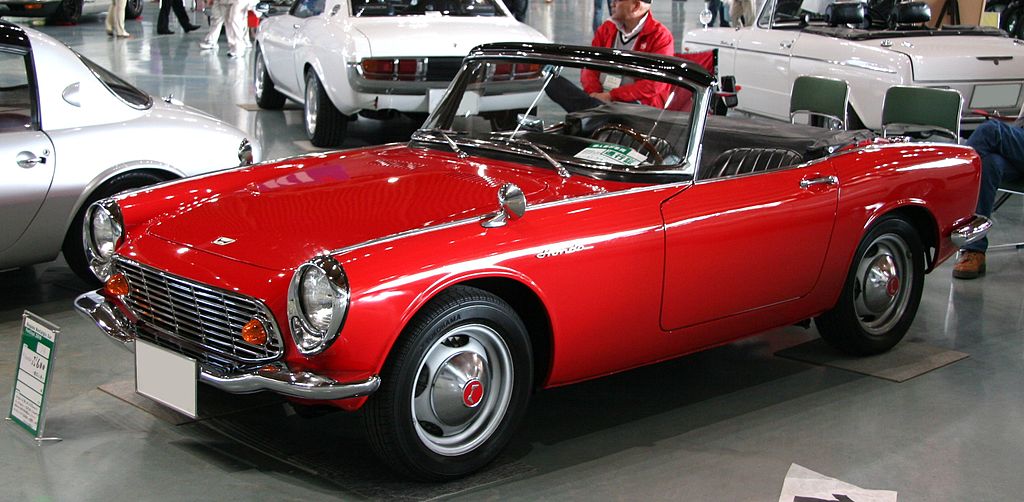 © Wikimedia.org/TTTNIS, CC0
© Wikimedia.org/TTTNIS, CC0
The Honda S800 is a sports car from Honda. Introduced at the 1965 Tokyo Motor Show, the S800 replaced the successful Honda S600 as the company's image car. With a redline of 9,500 rpm, it is one of the highest-revving sports cars produced for street use. The S800 competed with the Austin-Healey Sprite, MG Midget, Triumph Spitfire, Datsun Fairlady, and Fiat 850 Spider. Like the S600, the S800 was available as either a coupe or roadster, and continued the advanced technology of its predecessors. The 791 cc straight-4 engine produced 70 hp (52 kW) at 8000 rpm, thus making this Honda's first 100 mph (160 km/h) automobile, but still allowing for 35 mpg (6.7 L/100 km). In April 1967 the car was described as the fastest production 1-litre car in the world thanks to its high revving engine (up to 10,000 rpm) and the manufacturer's history of manufacturing powerful relatively low capacity motor-cycle engines. (Source: Wikipedia.org, CC BY-SA)
The Hudson Hornet is a full-sized automobile that was manufactured by Hudson Motor Car Company of Detroit, Michigan from 1951 until 1954, when Nash-Kelvinator and Hudson merged to form American Motors Corporation (AMC). Hudson automobiles continued to be marketed under the Hudson brand name through the 1957 model year. The first-generation Hudson Hornets featured a functional 'step-down' design with dropped floorpan and a chassis with a lower center of gravity than contemporary vehicles that helped the car handle well — an advantage for racing. The Hornet's lower and sleeker look was accentuated by streamlined styling, sometimes called 'ponton' styling. (Source: Wikipedia.org, CC BY-SA)
 © Wikimedia.org/Alf Helin, CC BY
© Wikimedia.org/Alf Helin, CC BY
The Hyundai Accent (Korean: 현대 엑센트), or Hyundai Verna (현대 베르나) is a subcompact car produced by Hyundai. In Australia, the first generation models carried over the Hyundai Excel name used by the Accent's predecessor. The Accent was replaced in 2000 by the Hyundai Verna in South Korea, although most international markets, including the US, retained the 'Accent' name. The 'Accent' name is an abbreviation of Advanced Compact Car of Epoch-making New Technology. (Source: Wikipedia.org, CC BY-SA)
The Hyundai Elantra, also known as the Hyundai Avante (Korean: 현대 아반떼), is a compact car produced by the South Korean manufacturer Hyundai since 1990. The Elantra was initially marketed as the Lantra in Australia and some European markets. In Australia, this was due to the similarly named Mitsubishi Magna Elante model; similarly, in other markets, the name Avante is not used due to its similarity with Audi's 'Avant' designation, which is used for their line-up of station wagons. The name was standardized as 'Elantra' worldwide in 2001 (except in South Korea and Singapore). (Source: Wikipedia.org, CC BY-SA)
 © Wikimedia.org/IFCAR, CC0
© Wikimedia.org/IFCAR, CC0
The Hyundai Excel (Korean: 현대 엑셀), also known as the Hyundai Pony, Hyundai Pony Excel, Hyundai Presto, Mitsubishi Precis and Hyundai X2, is an automobile which was produced by Hyundai Motor Company from 1985 to 2000. It was the first front-wheel drive car produced by the South Korean manufacturer. The Excel range replaced the rear-wheel-drive Hyundai Pony. The Excel was based on the second generation of the Mitsubishi Mirage, but it received its own sheet metal design by Giorgetto Giugiaro. The Excel was available in three- or five-door hatchback and four-door sedan models. The Excel was the first Hyundai car to be exported to the United States. The Excel was available with either a manual or automatic transmission mated to a four-cylinder engine aspirated by a carburetor or fuel injection system, depending on market and model year. (Source: Wikipedia.org, CC BY-SA)
 © Wikimedia.org/SealyPhoto, CC BY-SA
© Wikimedia.org/SealyPhoto, CC BY-SA
The Hyundai Genesis (Korean: 현대 제네시스) is an executive four-door, five passenger, rear or all-wheel-drive full-size luxury sedan manufactured and marketed by Hyundai. The Hyundai Genesis debuted in 2008 until Genesis spun off as a separate entity in 2017, rebadging the vehicle as the G80. Introduced in concept form at the 2007 New York International Auto Show, and internally designated as the BH model, the Genesis was expected to cost $533 million to develop. Hyundai began marketing the first generation Genesis worldwide (except in Europe) in 2008 as a 'premium sports sedan'. The second generation Genesis (model DH) debuted in Seoul, Korea in November 2013 followed by the 2014 North American International Auto Show and Toronto Auto Show. It is marketed worldwide. On 4 November 2015, Hyundai officially separated Genesis into its own luxury division, Genesis Motor. The leap into a stand-alone, luxury brand came on the heels of marked success in the luxury market, paired with consumer demand for the Genesis name. (Source: Wikipedia.org, CC BY-SA)
The Hyundai Grandeur (Korean: 현대 그랜저) is an executive sedan manufactured and marketed by the South Korean manufacturer Hyundai since 1986. From 1986 to 1996, the Grandeur was the flagship for Hyundai's South Korean range before the Hyundai Dynasty was introduced. The Grandeur has evolved through five generations with intermediate restylings, and is marketed under various nameplates worldwide—prominently as the Hyundai Azera. As the Azera, it was the flagship of Hyundai's US and Canadian lineup until the arrival of the Genesis sedan. After the launch of the separate Genesis brand, the Grandeur/Azera resumed its place as the company's flagship. As of the 2017 model year, the Azera is no longer marketed in the United States and Canada. The sedan continued to be available in South Korea and the Middle East. (Source: Wikipedia.org, CC BY-SA)
The Hyundai Ioniq is a compact five-door liftback manufactured and marketed by Hyundai. The nameplate Ioniq is a portmanteau of ion and unique. It is marketed as the first automobile to be offered without a standard internal combustion engine, but rather sold in hybrid, plug-in hybrid, and all-electric variants. The Ioniq Hybrid debuted in South Korea in January 2016, with all three variants debuting at 2016 Geneva and New York auto shows. The hybrid variant launched in its home market in February 2016, followed by the electric model in July 2016. The plug-in hybrid version followed in February 2017. From its first model year (2017) through the 2019 model year, the Ioniq Electric had been the EPA's most efficient vehicle with a rated fuel economy of 136 miles per gallon gasoline equivalent (25.3 kWh/100 mi; 15.7 kWh/100 km). The Ioniq Blue Hybrid version has been rated at 4.1 L/100 km (58 mpg‑US), making it the most fuel-efficient hybrid vehicle to be mass-produced. (Source: Wikipedia.org, CC BY-SA)
The Hyundai Santa Fe (Korean: 현대 싼타페) is a sport utility vehicle (SUV) produced by the South Korean manufacturer Hyundai since 2000. It is named after the city of Santa Fe, New Mexico, and was introduced for the 2001 model year as Hyundai's first SUV. The Santa Fe was a milestone in the company's restructuring program of the late 1990s because the SUV was a hit with American buyers. Between 2006 and 2012, the Santa Fe was positioned between the smaller Tucson compact crossover and the larger Veracruz. The third-generation Santa Fe introduced in 2012 was available in two versions, which are regular (short) and extended long-wheelbase version. The short model was sold as the Santa Fe Sport in North America (three-row seating was not available) and simply Santa Fe in global markets (three-row seating was standard or optional), while the extended long-wheelbase model is called the Santa Fe in the USA, Santa Fe XL in Canada and called the Hyundai Maxcruz in South Korea. (Source: Wikipedia.org, CC BY-SA)
The Hyundai Sonata is a mid-size car that has been manufactured by Hyundai since 1985. The first generation Sonata, which was introduced in 1985, was a facelifted Hyundai Stellar with an engine upgrade, and was withdrawn from the market in two years due to poor customer reaction. While the nameplate was originally only sold in South Korea, the second generation of 1988 was widely exported. The Sonata is currently manufactured in South Korea, China and Pakistan. It was named after the musical term, sonata. (Source: Wikipedia.org, CC BY-SA)
The Hyundai Tiburon (Korean: 현대 티뷰론) known in Europe as the Hyundai Coupé (현대 쿠페) is a sports coupe that was produced by the South Korean manufacturer Hyundai from 1996 to 2008. The name 'Tiburon', a slight variation of 'tiburón', the Spanish word for 'shark', is the name given to the North American, Australian, New Zealand, South African, and Austrian production of the vehicle. It was known as the Hyundai Coupe in some European markets and Indonesia. It had been branded as the Turbulence (터뷸런스) and Tuscani (투스카니) in the home South Korean market. (Source: Wikipedia.org, CC BY-SA)
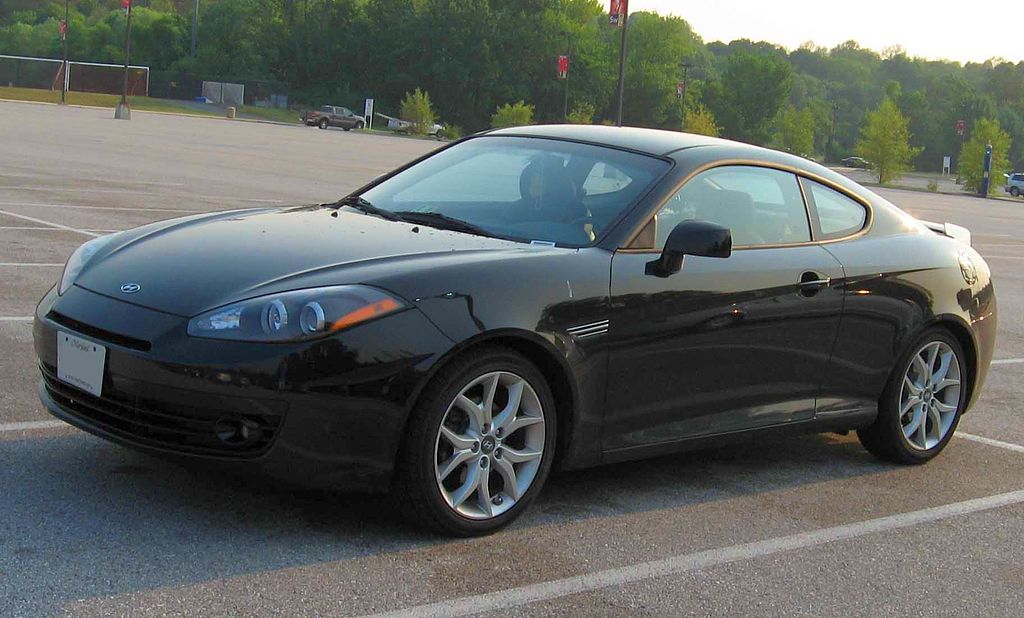 © Wikimedia.org/IFCAR, CC0
© Wikimedia.org/IFCAR, CC0
The Hyundai Tucson (Korean: 현대 투싼) (pronounced Tu-són) is a compact crossover SUV produced by the South Korean manufacturer Hyundai since 2004. In the brand's lineup, the Tucson is positioned below the Santa Fe, and above the Kona and Creta. It is named after the city of Tucson, Arizona. The second-generation model has been marketed as the Hyundai ix35 in several markets, including Europe, Australia and China, before reverting to Tucson for the third generation. The Tucson is the best-selling Hyundai SUV model, with more than 7 million units sold globally since it launched in 2004. Of these, 1.4 million units have been sold in Europe. (Source: Wikipedia.org, CC BY-SA)
The Hyundai Veracruz (Korean: 현대 베라크루즈), also known as the Hyundai ix55 in Europe and Russia, is a mid-size crossover that was manufactured by the South Korean manufacturer Hyundai from 2006 to 2015. The Veracruz was sold in the United States, Canada, South Korea, China, Morocco, South America and the Middle East. It was also imported to Europe and parts of Asia from 2007 to 2011. The Veracruz was discontinued in other countries, except South Korea. The official date of unveiling in South Korea was October 12, 2006, and was made available in the United States as a model of 2007. The Veracruz went on sale in March 2007, and is Hyundai's largest crossover SUV. (Source: Wikipedia.org, CC BY-SA)
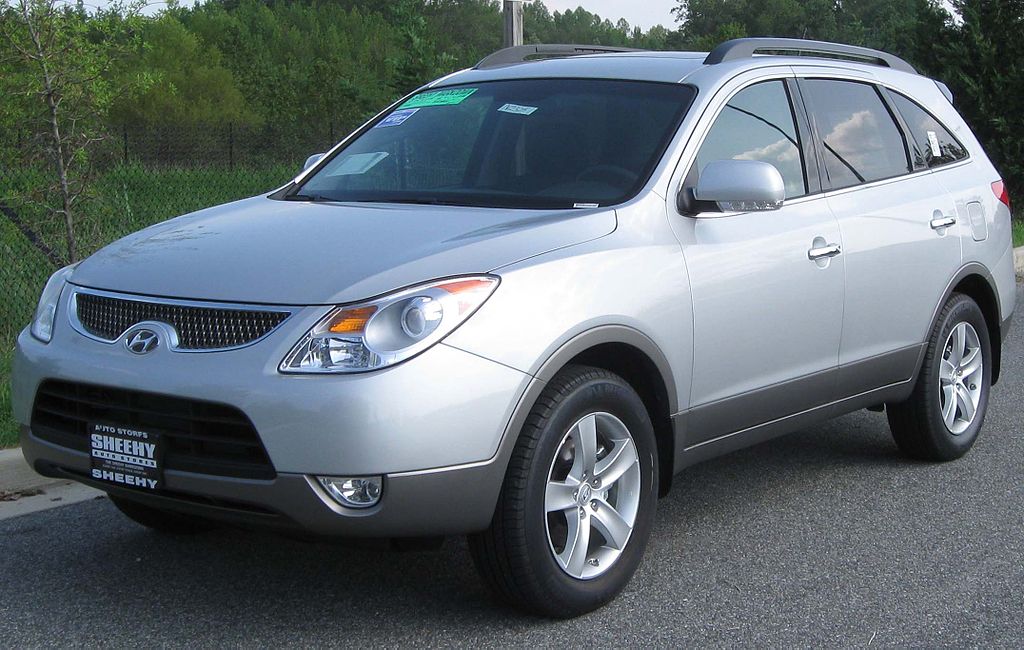 © Wikimedia.org/IFCAR, CC0
© Wikimedia.org/IFCAR, CC0
The Infiniti QX50, previously the Infiniti EX or Nissan Skyline Crossover until 2013, is a compact luxury crossover SUV produced by Infiniti, the luxury vehicle division of Japanese automaker Nissan. The first-generation QX50 is a minor model update of the EX, while also changing the nameplate to QX50 in line with the marque's new Q and QX nomenclature, which took place for the 2013 (China) and 2015 (United States) model years. The second-generation QX50 entered production in November 2017 as a 2019 model. (Source: Wikipedia.org, CC BY-SA)
The Infiniti QX60, called the Infiniti JX until the 2014 model year, is a mid-size luxury crossover SUV with three-row seating produced by Infiniti, the luxury vehicle division of Japanese automaker Nissan. It is underpinned by an elongated Nissan Murano platform also used by the Nissan Pathfinder. In keeping with Infiniti's naming scheme for 2014, in which cars begin with Q and SUVs begin with QX, the JX was renamed to QX60. While the number previously denoted engine displacement (for example, 35=3.5L engine), the new number, 60, is largely to do with its place in the product lineup, with larger numbers usually corresponding to more expensive vehicles. (Source: Wikipedia.org, CC BY-SA)
The Jaguar C-Type (officially called the Jaguar XK120-C) is a racing sports car built by Jaguar and sold from 1951 to 1953. The 'C' stands for 'competition'. The car combined the running gear of the contemporary, road-proven XK120, with a lightweight tubular frame designed by Jaguar Chief Engineer William Heynes, and an aerodynamic aluminium body, jointly developed by William Heynes, R J (Bob) Knight and later Malcolm Sayer. A total of 53 C-Types were built, 43 of which were sold to private owners, mainly in the US. (Source: Wikipedia.org, CC BY-SA)
The Jaguar D-Type is a sports racing car that was produced by Jaguar Cars Ltd. between 1954 and 1957. Designed specifically to win the Le Mans 24-hour race, it shared the straight-6 XK engine and many mechanical components with its C-Type predecessor. Its structure, however, was radically different, with innovative monocoque construction and slippery aerodynamics that integrated aviation technology, including in some examples a distinctive vertical stabilizer. Engine displacement began at 3.4 litres, was enlarged to 3.8 L in 1957, and reduced to 3.0 L in 1958 when Le Mans rules limited engines for sports racing cars to that maximum. D-Types won Le Mans in 1955, 1956 and 1957. After Jaguar temporarily retired from racing as a factory team, the company offered the remaining unfinished D-Types as street-legal XKSS versions, whose perfunctory road-going equipment made them eligible for production sports car races in America. In 1957 25 of these cars were in various stages of completion when a factory fire destroyed nine of them. (Source: Wikipedia.org, CC BY-SA)
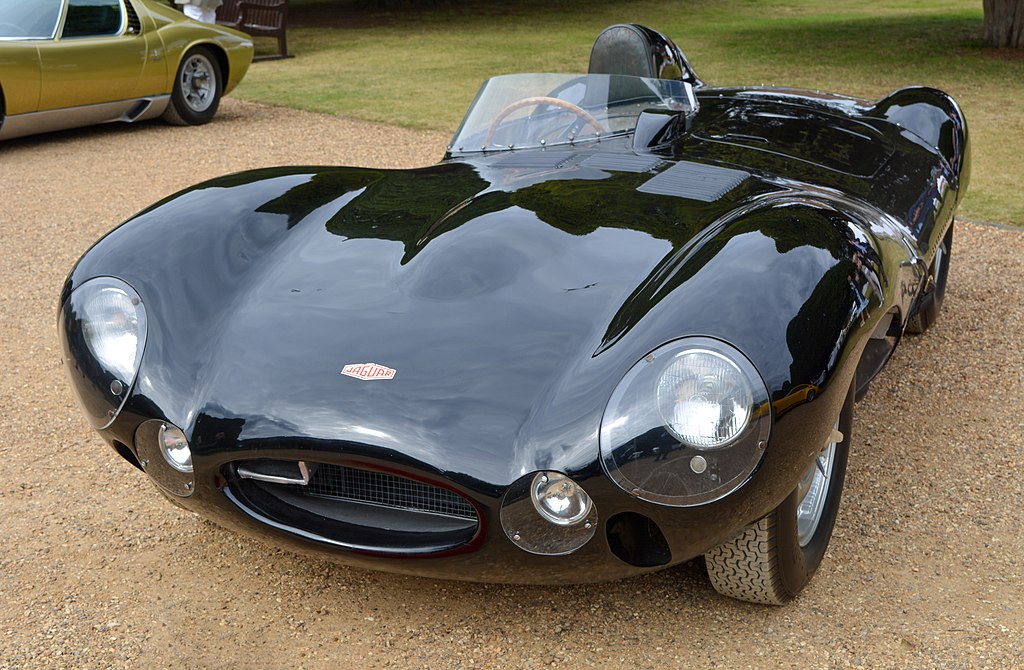 © Wikimedia.org/Craig James, CC BY-SA
© Wikimedia.org/Craig James, CC BY-SA
The Jaguar E-Type, or the Jaguar XK-E for the North American market, is a British sports car that was manufactured by Jaguar Cars Ltd between 1961 and 1974. Its combination of beauty, high performance, and competitive pricing established the model as an icon of the motoring world. The E-Type's claimed 150 mph (241 km/h) top speed, sub-7-second 0 to 60 mph (97 km/h) acceleration, unitary construction, disc brakes, rack-and-pinion steering, and independent front and rear suspension distinguished the car and spurred industry-wide changes. The E-Type was based on Jaguar's D-Type racing car, which had won the 24 Hours of Le Mans for three consecutive years beginning in 1955. (Source: Wikipedia.org, CC BY-SA)
The Jaguar Mark 1 is a British saloon car produced by Jaguar between 1955 and 1959. It was referred to in contemporary company documentation as the Jaguar 2.4 Litre and Jaguar 3.4 Litre. Its designation as Mark 1 was retroactive, following its October 1959 replacement by Jaguar's 2.4-litre Mark 2. The 2.4 Litre was the company's first small saloon since the end of its 1½ and 2½ Litre cars in 1949, and was an immediate success, easily outselling the larger much more expensive Jaguar saloons. The 2.4 Litre saloon was announced on 28 September 1955. The 3.4 Litre saloon announced 17 months later in the U.S. on 26 February 1957 was designed for the American market and was not at first freely available on the domestic market. (Source: Wikipedia.org, CC BY-SA)
The Jaguar Mark 2 is a mid-sized luxury sports saloon built from late 1959 to 1967 by Jaguar in Coventry, England. The previous Jaguar 2.4 Litre and 3.4 Litre models made between 1955 and 1959 are identified as Mark 1 Jaguars. The Mark 2 was a fast and capable saloon in line with Sir William Lyons' 1950s advertising slogan: Grace . . . Space . . . Pace, available with all three versions of the advanced Jaguar XK6 I6 engine, the 2.4, 3.4, and 3.8 litre. Production of the 3.8 ended in the (northern) autumn of 1967, with discounted sale of the 3.4 continuing on as the 340 until September 1968, and the 2.4 as the 240 until April 1969. (Source: Wikipedia.org, CC BY-SA)
The Jaguar X-Type is a car built by British marque Jaguar from 2001 to 2009. Considered a large family car in Europe and a compact car in the US, the X-Type was part of the compact-executive market segment and was sold in four-door saloon and five-door estate body styles. Given the internal designation X400,[citation needed] it was front engined and sold with both front-wheel drive and all-wheel drive variants. In addition to offering Jaguar's first estate car in series production, the X-Type would ultimately introduce its first diesel engine, four-cylinder engine and front-wheel drive configuration. (Source: Wikipedia.org, CC BY-SA)
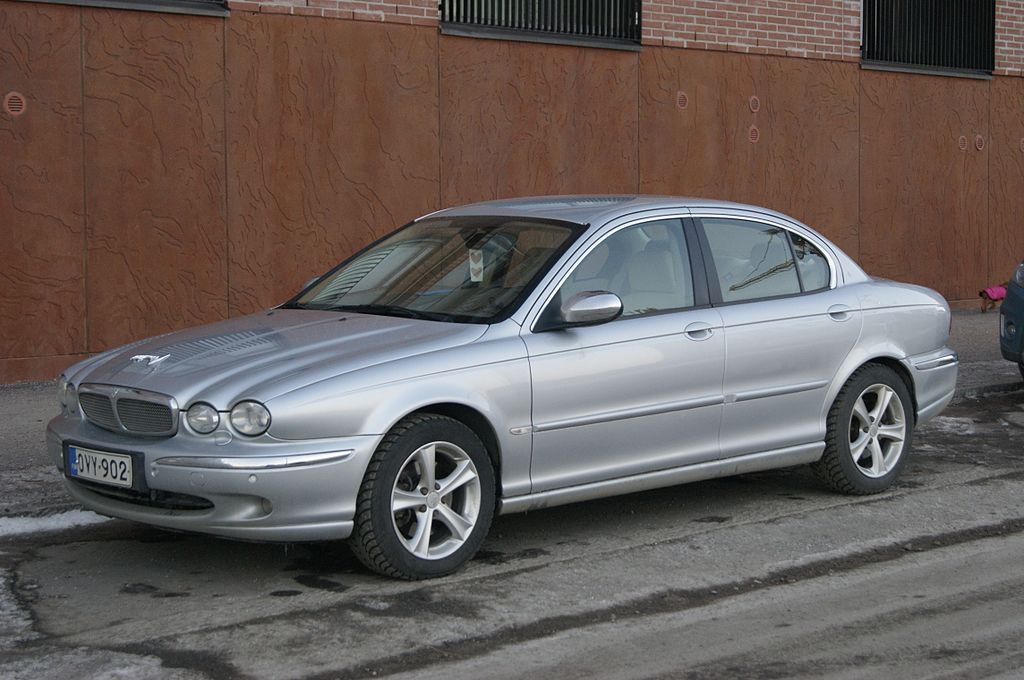 © Wikimedia.org/Dogs.barking.duster.rolling, CC BY-SA
© Wikimedia.org/Dogs.barking.duster.rolling, CC BY-SA
The Jaguar XF (X260) is an executive/mid-size luxury sports saloon manufactured and marketed by the Jaguar Cars brand of Jaguar Land Rover in sedan/saloon and station wagon/estate body styles. Following the first generation steel-bodied X250 XF introduced in 2007, the second-generation XF sedan/saloon debuted at the 2015 New York International Auto Show, noted for its aluminium bodywork. As of 2022, the XF has been downgraded to compete in the D-segment while retaining its E-segment exterior dimensions. (Source: Wikipedia.org, CC BY-SA)
The Jaguar XJ is a series of full-size luxury cars produced by British automobile manufacturer Jaguar Cars (becoming Jaguar Land Rover in 2013) from 1968 to 2019. It was produced across five basic platform generations (debuting in 1968, 1986, 1994, 2003 and 2009) with various updated derivatives of each. From 1970 it was Jaguar's flagship four door model. The original model was the last Jaguar saloon to have had the input of Sir William Lyons, the company's founder, and the model has been featured in countless media and high-profile appearances. (Source: Wikipedia.org, CC BY-SA)
The Jaguar XJ220 is a two-seat sports car produced by British luxury car manufacturer Jaguar from 1992 until 1994, in collaboration with the specialist automotive and race engineering company Tom Walkinshaw Racing. The XJ220 recorded a top speed of 212.3 mph (341.7 km/h) during testing by Jaguar at the Nardo test track in Italy. This made it the fastest production car from 1992 to 1993. According to Jaguar, an XJ220 prototype managed a Nürburgring lap time of 7:46.36 in 1991 which was faster than any production car lap time before it. The XJ220 was developed from a V12-engined 4-wheel drive concept car designed by an informal group of Jaguar employees working in their spare time. The group wished to create a modern version of the successful Jaguar 24 Hours of Le Mans racing cars of the 1950s and 1960s that could be entered into FIA Group B competitions. The XJ220 made use of engineering work undertaken for Jaguar's then current racing car family. (Source: Wikipedia.org, CC BY-SA)
The Jaguar Sport XJR-15 is a two-seater sports car produced by JaguarSport, a subsidiary of Jaguar and Tom Walkinshaw Racing between 1990 and 1992. Only 50 were planned (although 53 chassis were eventually made), each selling for £500,000. The chassis was mechanically based on the Le Mans-winning XJR-9, designed by Tony Southgate. The body of the XJR-15 was designed by Peter Stevens, who went on to co-design the McLaren F1. The car competed in a single-make racing series called the Jaguar Intercontinental Challenge, which supported three Formula 1 races (Monaco, Silverstone and Spa) in 1991. The XJR-15 was the world's first road-car made entirely from carbon-fibre. (Source: Wikipedia.org, CC BY-SA)
The Jaguar XJ-S (later called XJS) is a luxury grand tourer manufactured and marketed by British car manufacturer Jaguar Cars from 1975 to 1996, in coupé, fixed-profile and full convertible bodystyles. There were three distinct iterations, with a final production total of 115,413 units over 20 years and seven months. Originally developed using the platform of the then-current XJ saloon, the XJ-S was noted for its prominent rear buttresses. The early styling was partially by Jaguar's aerodynamicist Malcolm Sayer—one of the first designers to apply advanced aero principles to cars—however Sayer died in 1970, before the design was finalised. (Source: Wikipedia.org, CC BY-SA)
The Jaguar XK is a two-door 2+2 grand tourer manufactured and marketed by British automobile manufacturer Jaguar Cars from 1996–2014 in hatchback coupé and convertible bodystyles, across two generations. The XK was introduced at the Geneva Motor Show in March 1996 and was discontinued in July 2014. The first generation was marketed as the XK8, replacing the XJS and was Jaguar's first 8-cylinder model since the Daimler 250, introducing the all-new Jaguar AJ-V8 engine. The XK8 shared its platform with the Aston Martin DB7 which was itself based on the stillborn XJ41/42 project built on a modified XJ-S chassis conceived in the mid-1980s. The second generation of the XK, noted for its aluminium monocoque chassis and construction, was launched in 2006 for the 2007 model year. The XKR performance variant was introduced in both of the generations with the second generation also offering a more powerful XKR-S variant. (Source: Wikipedia.org, CC BY-SA)
The Jaguar XK120 is a sports car manufactured by Jaguar between 1948 and 1954. It was Jaguar's first sports car since SS 100 production ended in 1939. The XK120 is a highly desirable model. In 2016, Bonhams sold a matching numbers left-hand-drive alloy-bodied roadster - one of only 184 - for $396,000 (£302,566). This marks the highest price achieved for an XK120 at auction so far. The XK120 was launched in open two-seater or (US) roadster form at the 1948 London Motor Show as a testbed and show car for the new Jaguar XK engine designed by Jaguar Chief Engineer William Heynes. The display car was the first prototype, chassis number 660001. It looked almost identical to the production cars except that the straight outer pillars of its windscreen were curved on the production version. The sports car caused a sensation, which persuaded Jaguar founder and Chairman William Lyons to put it into production. (Source: Wikipedia.org, CC BY-SA)
The Jaguar XK150 is a sports car produced by Jaguar between 1957 and 1961 as the successor to the XK140. Initially it was only available in fixed head coupé (FHC) and drophead coupé (DHC) versions. The roadster without full weather equipment which had begun the XK line was launched as the XK150 OTS (open two-seater) in 1958. Minimal rear seats were fitted in the coupés. The open two-seater was fitted for the first time with wind-up windows in taller high-silled doors, but retained the very simple folding roof of its predecessors. (Source: Wikipedia.org, CC BY-SA)
The Jeep CJ models are a series and a range of small, open-bodied off-road vehicles and compact pickup trucks, built and sold by several successive incarnations of the Jeep automobile marque from 1945 to 1986. The 1945 Willys Jeep was the world's first mass-produced civilian four-wheel drive car. In 1944, Willys-Overland, one of the two main manufacturers of the World War II military Jeep, built the first prototypes for a commercial version – the CJ, short for 'civilian Jeep'. From then on, all CJ Jeeps consistently had a separate body and frame, rigid live axles with leaf springs both front and rear, a tapering nose design with flared fenders, and a fold-flat windshield, and could be driven without doors. Also, with few exceptions, they had part-time four-wheel drive systems, with the choice of high and low gearing, and open bodies with removable hard or soft tops. (Source: Wikipedia.org, CC BY-SA)
The Jeep Cherokee is a line of SUVs manufactured and marketed by Jeep over five generations. Originally marketed as a variant of the Jeep Wagoneer, the Cherokee has evolved from a full-size SUV to one of the first compact SUVs and into its current generation as a crossover SUV. Named after the Cherokee tribe of North American Indians, Jeep has used the nameplate in some capacity since 1974. The Cherokee was a rebadged reintroduction of a two-door body style Jeep Wagoneer, with a redesigned greenhouse that eliminated the car's C-pillar. Instead the Cherokee sported a much wider D-pillar and a single, long fixed rear side window with an optional flip-out section. Previously, a two-door version had been available in the Jeep Wagoneer line (from 1963 to 1967), although this had the same pillar and window configuration as the four-door Wagoneer. The Cherokee replaced the Jeepster Commando, whose sales had not met expectations despite an extensive 1972 revamp. The Cherokee appealed to a younger market than the Wagoneer, which was regarded more as a family SUV. (Source: Wikipedia.org, CC BY-SA)
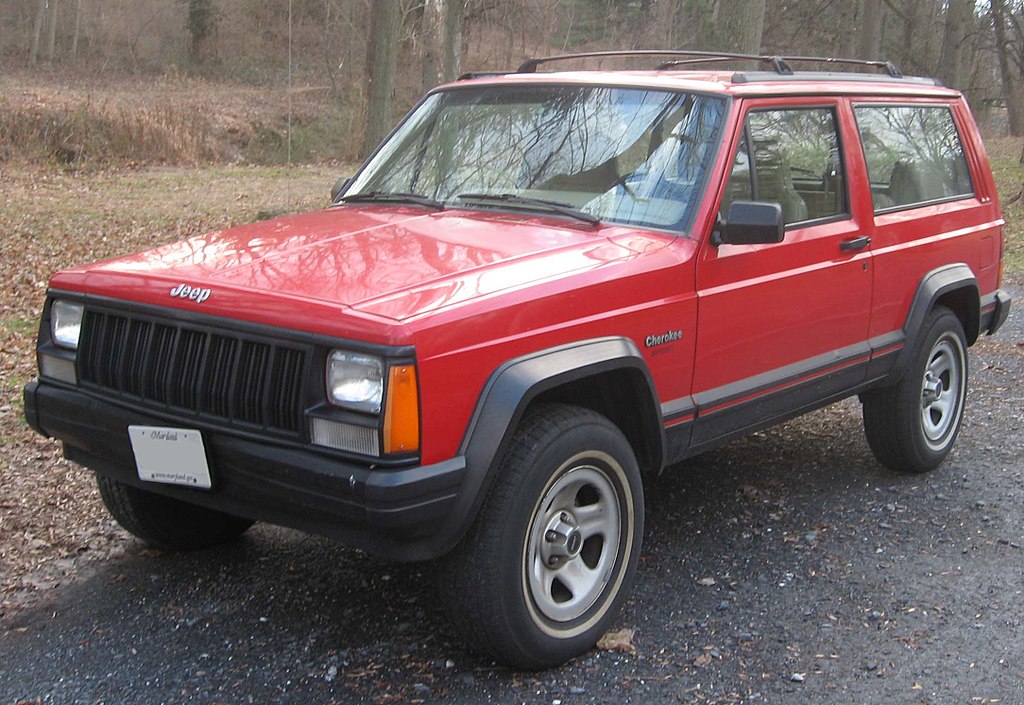 © Wikimedia.org/IFCAR, CC0
© Wikimedia.org/IFCAR, CC0
The Jeep Compass is a compact crossover SUV introduced for the 2007 model year, and is currently in its second generation. The first generation Compass and Patriot, its rebadged variant, were among Jeep's first crossover SUVs. The second-generation Compass debuted in September 2016 in Brazil and at the Los Angeles International Auto Show in November 2016, sharing a modified platform with the Renegade. It is positioned between the smaller Renegade and the larger Cherokee globally or the Commander in South America. (Source: Wikipedia.org, CC BY-SA)
The Jeep Renegade is a subcompact crossover SUV produced by Stellantis under their Jeep marque. It was first shown to the public in March 2014 at the Geneva Motor Show and production started in late August of that year. As of 2022, the Renegade is the smallest vehicle that is currently marketed by Jeep, slotting below the Compass. It is based on the FCA Small Wide 4×4 platform which is also shared with other FCA models, including from Fiat and Alfa Romeo brands. The Renegade came standard with front-wheel drive, with optional four-wheel drive systems Active Drive I and Active Drive Low, both of which are paired with Jeep's Selec-Terrain System. (Source: Wikipedia.org, CC BY-SA)
The Jeep Wrangler is a series of compact and mid-size four-wheel drive off-road SUVs manufactured by Jeep since 1986, and currently in its fourth generation. The Wrangler JL, the most recent generation, was unveiled in late-2017 and is produced at Jeep's Toledo Complex. The Wrangler is a direct progression from the World War II Jeep, through the CJ (Civilian Jeeps) produced by Willys, Kaiser-Jeep and American Motors Corporation (AMC) from the mid-1940s through 1980s. Although neither AMC nor Chrysler (after its purchase of AMC in 1987) have claimed that the Wrangler was a direct descendant of the original military model — both the CJ Jeeps and the conceptually consistent Wrangler, with their solid axles and open top, have been called the Jeep model as central to Jeep's brand identity as the rear-engine 911 is to Porsche. (Source: Wikipedia.org, CC BY-SA)
The Jensen Interceptor is a grand touring car which was hand-built at the Kelvin Way Factory in West Bromwich, near Birmingham in England, by Jensen Motors between 1966 and 1976. The Interceptor name had been used previously by Jensen for the Jensen Interceptor made between 1950 and 1957 at the Carters Green factory. Jensen had extensively used glass-reinforced plastic for the fabrication of body panels in the preceding two decades, but the new Interceptor saw a return to a steel body-shell. The body was designed by an outside firm, Carrozzeria Touring of Italy, rather than the in-house staff. The early bodies were built in Italy by Vignale, before Jensen took production in house, making some subtle body modifications. (Source: Wikipedia.org, CC BY-SA)
The Kia Carnival (Korean: 기아 카니발) is a minivan manufactured by Kia since 1998. It is marketed globally under various nameplates — prominently as the Kia Sedona — which is now unused in favor of the Carnival. The first generation Carnival was introduced in September 1998, and was marketed in a single, short wheelbase version. Second generation models were marketed (2006–2014) in short and long wheelbase variants. A rebadged variant of the second generation was offered in North America as the Hyundai Entourage (2007–2009). Beginning in 2010, the second generation model received updated equipment, including Kia's corporate Tiger Nose grille, as introduced by its then new design chief, Peter Schreyer. Kia introduced its third generation minivan in 2014, solely in a long wheelbase format. The fourth generation was introduced in 2020, when Kia also began using the Carnival nameplate worldwide. (Source: Wikipedia.org, CC BY-SA)
The Kia Forte, known as the K3 in South Korea, the Forte K3 or Shuma in China and Cerato in South America, Australia, New Zealand and Russia, is a compact car manufactured by South Korean automaker Kia since mid-2008, replacing the Kia Spectra. It is available in two-door coupe, four-door sedan, five-door hatchback variants. It is not available in Europe, where the similar sized Kia Ceed is offered (except for Russia and Ukraine, where the Ceed and the Forte are both available). In some markets, such as Costa Rica, Australia and Brazil, the Forte is marketed as Kia Cerato, replacing its predecessor of the same name. In Colombia and Singapore, the name Cerato Forte was used for the second generation, while Naza Automotive Manufacturing of Malaysia has assembled the vehicle since 2009, selling it there under the name Naza Forte. (Source: Wikipedia.org, CC BY-SA)
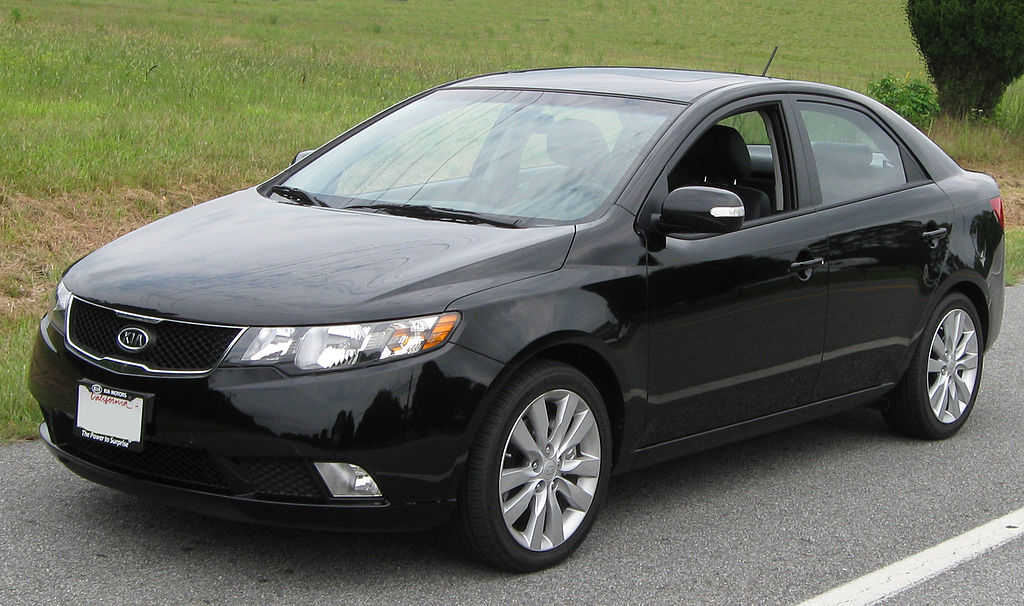 © Wikimedia.org/IFCAR, CC0
© Wikimedia.org/IFCAR, CC0

Time for recess! Post a comment, ask a question or write a review. Feel free to let us know what you think!
look at the sign on the road to avoid accidents and horrible driving conditions
I received a 300$ ticket because I passed a police control of other cars/drivers on the right lane of a highway (the control was on the hard shoulder of the highway). Is it really true, that you have to change the lane in such cases? Thanks!
I am an American living in Italy. The Italian Drivers License theory test is the hardest test I have ever studied for and I am in my 70s have multiple degrees, multiple professional certifications. Have to take the Italian Drivers Theory test in Italian. No english. So many rules. More signs in small medieval Italian town I live in then in major US cities I have lived in. No Italian license no driving. No buying or renting a car. Test here was good, clean. Lots of tricky questions on many practice and real official tests. Thanks
Most problems are a result of higher than safe driving speeds. Please just slow down and be patient.
Question 121: Poor translation: Vehicles with polluted fluids prohibited Should be translated as: Vehicles with dangerous liquids prohibited
Question 83: Poor translation: Vehicles with polluted fluids prohibited Should be translated as: Vehicles with dangerous liquids prohibited
Want even more practice? Visit similar websites offering realistic practice driving knowledge tests. Visit us to see what sets our tests apart! https://dkttest.com/capital-territory/
Cool tool! And fun to check whether I remember the rules :) Two things I noticed: Warning for a crossroad side roads on the left and right. While technically that might be the correct translation, this sign tells you, that you are on the main road and have the right of way for the next crossroad and only the next crossroad. Usually (if no sign specifies otherwise) you have to give way to drivers coming from the right at every intersection, which can get a bit annoying in communal areas, so seeing this sign feels less like a warning and more like relief :). A Fahrradstraße is not a lane for cyclists but a street for cyclists, meaning the (whole!) street is intended predominantly for cyclists, who are then allowed to ride next to each other. Cars are allowed to drive there (unless another sign prohibits such), but have to adjust their speed to the cyclists. I believe they are not allowed to pass at all, even if the oncoming lane is empty.
More community